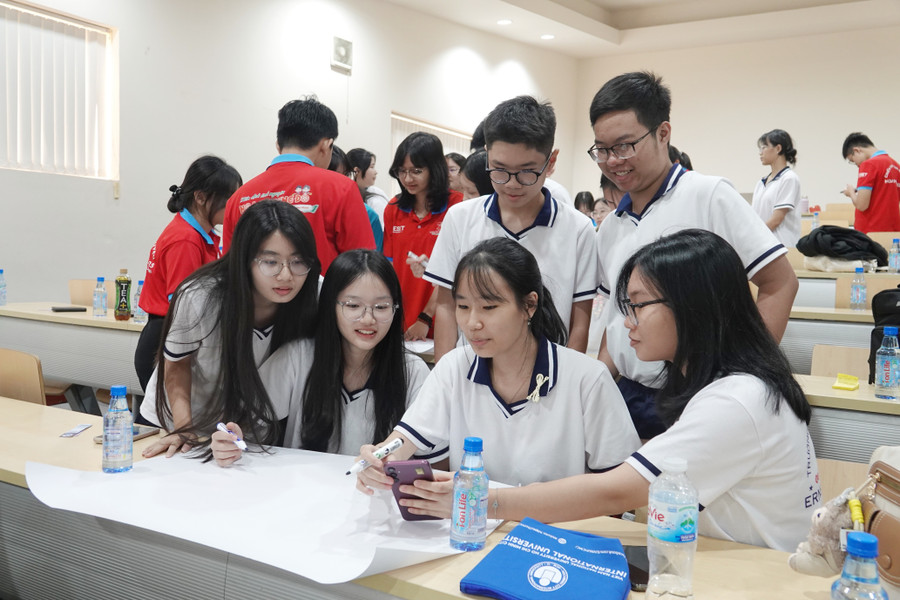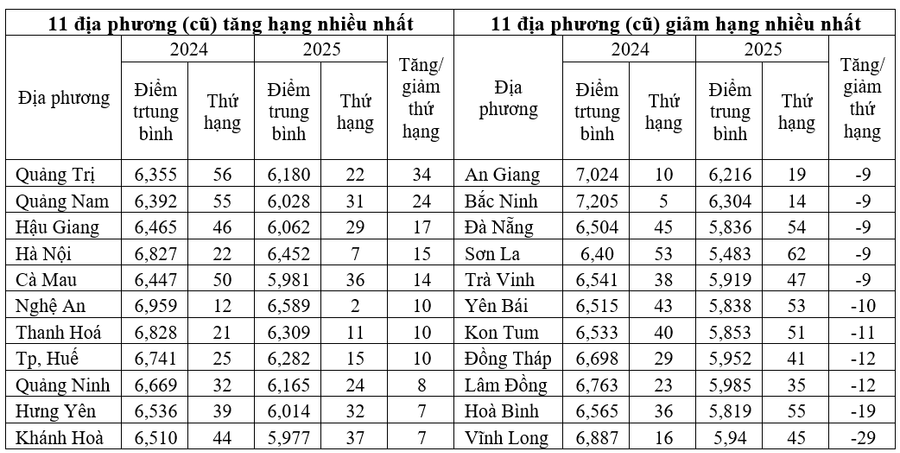Bright spots from innovation to substance
The first highlight is the change in the assessment method. If in the past the exam mainly tested memory, this year, in the subjects of Math, English, Physics, Chemistry, Biology, Economic and Legal Education, etc., many questions are related to practical situations, requiring students to understand the nature, think logically and apply knowledge flexibly. "Memorization" is no longer enough, students must practice problem-solving skills; teachers have switched from "explaining" to "guiding and stimulating thinking".
The test does not follow the textbook, the multiple choice part is supplemented with true/false and short answer. The Literature subject does not use materials from any textbook, enhances reading comprehension and social discussion, touches on the opinions and feelings of the young generation about the country's destiny. The foreign language test also assesses language proficiency. This is a change in line with the spirit of the 2018 General Education Program and the model of "one program - many textbooks".
The second bright spot is that the exam results clearly reflect differentiation: the average score decreased from 6.75 (in 2024) to 6.17, but the number of 10 points increased sharply from 10,878 to 15,331. The exam was well classified, helping universities and colleges recruit more accurately, limiting the situation of "slipping through the net" or "lack of resources". The exam ensures that truly excellent students have the conditions to develop and shine.
After the Math and Foreign Language exams, public opinion and students were upset that the exam was too difficult, exceeding the required standards. For example, the Foreign Language exam had questions that exceeded the B1 standard, equivalent to B2 or C1. However, the exam results showed that there were 513 10s in Math and 141 10s in English. The English score distribution was very standard, with only one peak (5.3 points) and evenly distributed on both sides of the peak, while in previous years the score distribution of this subject often had two peaks.
Another notable highlight is the move towards personalization. Candidates take 4 subjects, including 2 compulsory subjects (Math, Literature) and 2 elective subjects out of 8 subjects: Foreign language, Physics, Chemistry, Biology, Information Technology, Technology, History, Geography, Economic and Legal Education. This selection method is closer to the abilities, strengths and career orientation of each student. Unlike before, many students who did not use a foreign language in the admission process still had to take the exam, or did not intend to take the B00 block but still had to take the Chemistry and Biology test when choosing the Natural Science group.
At the same time, the 2025 high school graduation exam will achieve the “3 in 1” goal: graduation assessment, providing admission data for universities and colleges, and serving as a basis for assessing teaching and learning quality. Graduation assessment scores are calculated 50% from the 3-year high school transcript. Universities do not consider early admissions, and if admission is based on high school transcript scores, the 12th grade second semester score is required. This forces students to make efforts from grade 10 and maintain them until the end of grade 12.
Teaching, learning and testing become more substantial, not "neglected" when knowing how to pass the university entrance exam early. If the school advises the right subjects according to ability, organizes teaching, learning and testing closely following the requirements of the 2018 General Education Program, students will achieve good results, and schools and localities can improve their rankings compared to 2024. On the contrary, if the advice and organization of teaching do not meet the new requirements, the results will decrease.
The organization of the exam shows progress in digital transformation. Online registration nationwide helps save time and reduce errors; the exam coding system has improved security. The full announcement of score distribution, median, standard deviation, percentile, inter-provincial comparison, etc. demonstrates transparency and science, helping society to perceive results based on objective data instead of emotions.
Finally, the exam provided an honest picture of the quality of teaching and learning after several years of implementing the new program. Many students were confused by practical problems and interdisciplinary questions, showing that there is still a gap between the current teaching method and the requirements of the 2018 General Education Program set out in the exam. From this data, the Ministry of Education and Training and schools have a basis to review textbooks, improve teaching methods, adjust testing and assessment, and ensure that the new program is implemented in the right direction.

11 localities increased and decreased in rank sharply
To assess the impact of the new testing method and new testing program on localities, we continue to maintain the same comparison with 63 localities as before, and compare the rankings between 2024 and 2025.
The comparison results show that 11 localities have significantly increased their rankings, while 11 others have significantly decreased their rankings. It is noteworthy that the opportunity to improve their rankings does not only come to disadvantaged localities - thanks to not having foreign language exams and choosing two subjects that suit their strengths - but also appears in localities with favorable conditions such as Hanoi, Hue, and Hung Yen.
On the contrary, some localities that had high rankings in previous years recorded a decline, typically Da Nang, Lam Dong, Vinh Long. This shows that the change in the examination method has created a significant shift in the rankings, reflecting the level of adaptation and effectiveness of implementing the 2018 General Education Program in each locality.
Shortcomings that need to be overcome soon
Despite many positive new points, the 2025 High School Graduation Exam still reveals a number of issues that need to be addressed.
Firstly, the results in many subjects are still low. The average score for Math is only 4.78; English is 5.38; Biology is 5.78. The percentage of candidates below average in some subjects is up to 30 - 56%. Notably, there are subjects with many 10s and low average scores, reflecting an unreasonable differentiation or the exam is not balanced with the general level.
Second, there is an imbalance in the selection of exam combinations. This year, the Social Science combination continues to dominate, while the Natural Science combination has decreased sharply. In particular, Biology has less than 70,000 registered students (equivalent to 6%). Many candidates choose "easy-to-score" combinations instead of basing on their abilities or career orientation, leading to the risk of human resource shortages for engineering, technology and STEM fields.
Part of the reason comes from uneven teaching conditions. In many remote areas, there is a lack of IT, technology, and foreign language teachers; limited laboratories; and outdated teaching equipment. Students are reluctant to choose these subjects because they lack a solid learning foundation.
Third, the evaluation of high school transcripts is still inconsistent. Using transcript scores to determine graduation is a good move, however, some schools are “loose” in giving scores, causing transcripts to not reflect the true abilities of students. Currently, there is no mechanism for cross-checking or standardizing criteria, leading to doubts about the fairness of combining transcripts with exam scores.

How to innovate teaching and testing?
For the high school graduation exam to truly become a driving force for improving education quality, many solutions need to be synchronously deployed.
First, improve the quality of teaching and learning and narrow the regional gap. Quality in schools must be the starting point; teachers need to be regularly trained in methods of capacity development, active classroom organization, and substantive assessment. Schools need to analyze the test results of each subject, point out knowledge gaps to adjust teaching content and test questions.
In particular, the subjects of Information Technology, Technology, and Natural Sciences need to be invested in synchronously in terms of human resources and facilities. Organizing two sessions/day combined with experience, STEM, and career guidance will help students connect learning with practice - the key factor for "real learning".
Second, perfecting the test questions and standardized question banks. The Ministry of Education and Training needs to build a standardized test bank, classified by cognitive level and ability area, in order to accurately assess the actual level of students. Applying technology to generate questions according to ability area will limit the situation of rote learning, and at the same time help classify students more accurately.
Third, standardize and digitize transcripts. It is necessary to build a unified national assessment framework, combining periodic test scores, learning projects and research products. Digitizing transcripts helps to monitor and compare conveniently, avoiding the situation of "loose hands" in grading. It is possible to pilot flexible graduation assessment based on exam scores or a combination of exam scores and transcripts, allowing students to choose the appropriate method.
Fourth, promote digital transformation in examinations. Towards organizing computer-based exams from 2027, it is necessary to invest in information technology infrastructure, especially in disadvantaged areas, starting with subjects with few candidates to gain experience. Computer-based exams will increase transparency and at the same time support data analysis for innovation.
Fifth, change the mindset from “exams to graduate” to “exams to develop learners”. The exam should be seen as an opportunity for students to demonstrate their abilities, arouse their aspirations and orient their careers. The rise of Nghe An, Ha Tinh, Thanh Hoa into the leading group along with Hanoi, Hai Phong, and Ho Chi Minh City shows that innovation in exams and general education programs has contributed to narrowing regional gaps.
In 2025, 9 valedictorians achieved 30/30 points in the university entrance exam groups. Notably, Tran Xuan Dam (My Loc High School, former Nam Dinh) with near-perfect results in 4 subjects: Math 10, Physics 10, Chemistry 9.75, Literature 9.25. This achievement not only comes from personal ability but also proves the spirit of self-study and learning to grow up.
From the results of this year's exam, the message is clear: If you want real learning, you need classes that stimulate independent thinking and learning methods; if you want real exams, you need exams that accurately classify abilities and transparent assessments. And if you want real talent, you need an entire education system that nurtures talent from high school, through further education, and into the workplace.
The high school graduation exam is just a milestone after 12 years of studying, but if we know how to take advantage of it, it will become a "push" for Vietnamese education to enter a new spirit - the spirit of honesty and creativity for the prosperous future of the nation.
Source: https://giaoducthoidai.vn/ky-thi-tot-nghiep-thpt-2025-khoi-dau-va-ky-vong-hoc-that-thi-that-nhan-tai-that-post750053.html





































![[Photo] Soldiers guard the fire and protect the forest](https://vphoto.vietnam.vn/thumb/1200x675/vietnam/resource/IMAGE/2025/9/27/7cab6a2afcf543558a98f4d87e9aaf95)





























































Comment (0)